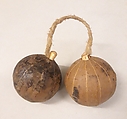Kesse kesse
Not on view
Pod rattles, such as this one in the Met’s collection, are found throughout West Africa and go by a variety of different names. One generic term for rattles, specifically in the Mandé region (present-day Senegal, Mali, Guinea, Guinea-Bissau and the Gambia), is kesse kesse.
This rattle’s simple construction consists of two seed pods filled with either small seeds or beads. The two seed pods are then attached using a piece of cord or string. This particular kesse kesse uses a small piece of wood to secure the cord between the two seed pods. The construction of kesse kesse, in general, does not rely on the iron tools of blacksmiths, and therefore may predate the beginnings of metalworking in West Africa in the mid-first millennium B.C.E.
These rattles’ complex polyrhythms are produced both internally, with the seeds or beads beating the inside of the pods, and externally, when the pods hit one another. They are played by threading the chord that ties the two pods together between one’s middle and index fingers, gripping one seed pod in the hand while the other hangs loose. The loose seed pod is then swung side to side through rapid rotations of the wrist. With each turn of the wrist, the loose pod strikes the in-hand pod, creating a satisfying percussive effect. Often two kesse kesse are played at once, in either hand, and especially good practitioners will use all four pods to create rhythmic textures that are both musically and visually striking. (Althea SullyCole, 2022)
Due to rights restrictions, this image cannot be enlarged, viewed at full screen, or downloaded.
This artwork is meant to be viewed from right to left. Scroll left to view more.


.jpg)
